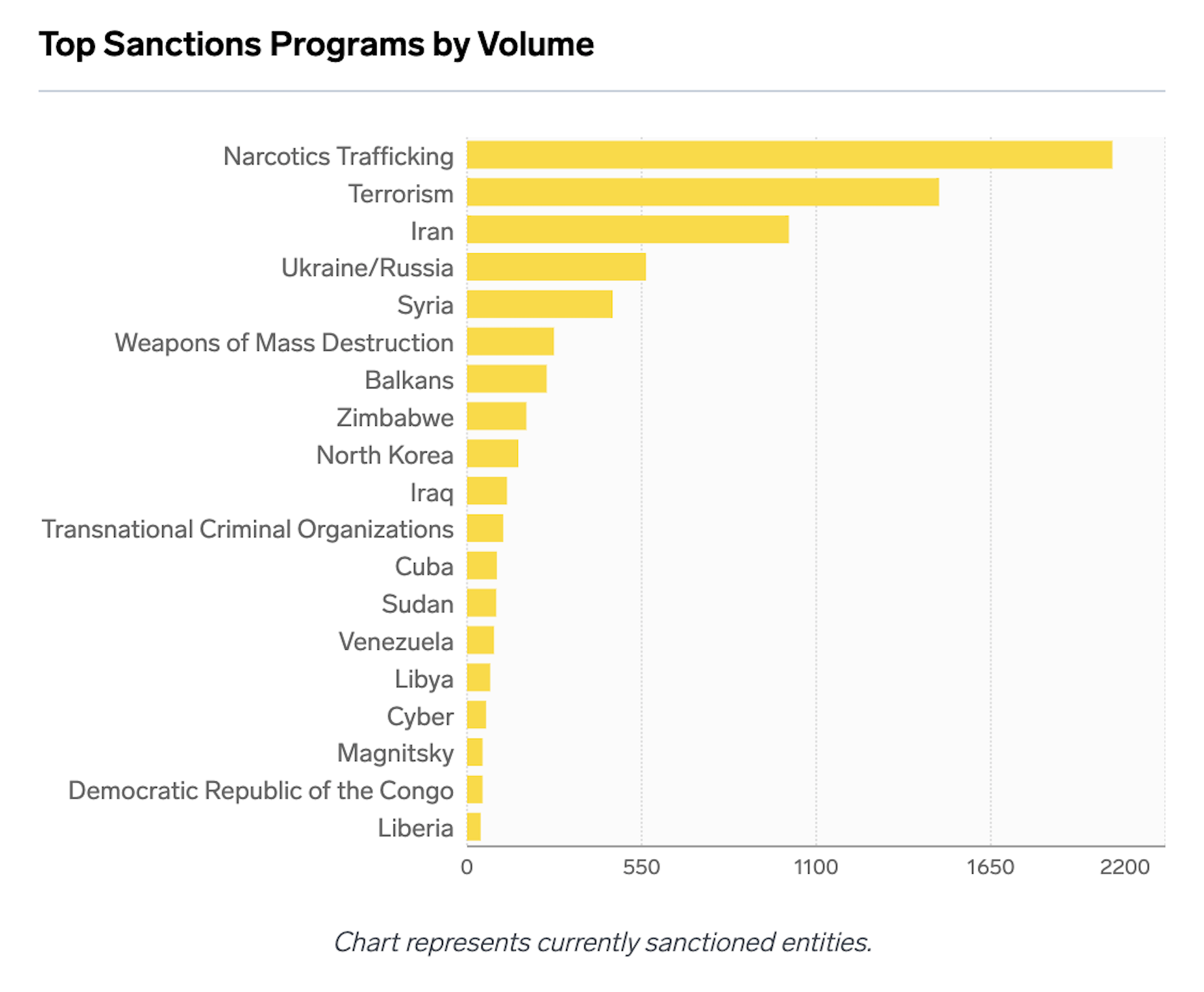Enigma Labs

Enigma Labs
Sanctions Tracker
Update: In April 2017, Enigma launched a tracker to monitor U.S. sanctions, which we maintained through September 2019. You can find up-to-date information about U.S. sanctions here.
United States Sanctions Tracker 1994 - 2019
What are sanctions?
Sanctions restrict business engagements of US companies and persons. The Department of Treasury’s Office of Foreign Assets Control (OFAC) imposes economic sanctions to achieve specific national security or foreign policy aims. Sanctions can be imposed on entire industries or in the case of the Specially Designated Nationals (SDN) list: targeted people, organizations, non-state actors and even boats. A program colloquially known as “North Korean Sanctions” for example, consists of a list of 82 individuals, 7 organizations, and 117 companies over the years.
What determines the list?
Executive action drives who is on the sanctions list. This is why the Sanctions Tracker is launching now — it will continue to monitor how the new Trump administration’s actions towards sanctions compare with those of the previous three administrations. Taking a data oriented approach to examining the past 20+ years of US sanctions makes it easier to contextualize and visualize changes to the program.
What are the penalties?
Since 1994 the SDN list has changed an average of 40 times per year. Businesses handling large volumes of transactions each day, such as banks, must keep up to date with each and every one of these changes, ensuring that no entity on either side of a transaction is subject to sanctions. Businesses caught engaging with a sanctioned entity are subject to fines, as well as potential civil and criminal penalty. Banks receive the largest financial penalties, such as the $8.9 billion fine paid by French bank BNP Paribas in 2014, but all business operating in the U.S. are subject. In 2016, for instance, Chicago-based PanAmerican Seed Company agreed to pay more than $4 million for violating the Iranian sanctions program.
Sanctions Program Landscape

Sanctions programs can be country-based or thematic. When appropriate, we have bundled several programs into larger categories. For instance, we combined 4 programs with titles such as “Specially Designated Terrorist [SDT]” and “Global Terrorism Sanctions Regulations [SDGT]” into a single “Terrorism” category.
General trends emerge when we group sanctions by category. Terrorism and narcotics sanctions eclipse country-level sanctions. That said, it should be noted that volume is not the only measure of the impact or effectiveness of a sanctions program. Effective programs are those that achieve their foreign policy aims, and targeted sanctions are only one tool. The Russia program, for instance, includes relatively few entries on the SDN list but entire industry sectors are potentially subject to sanctions, including financial services, defense, and energy.
Global Reach of Sanctions

Locating the Sanctioned
The US sanctions list encompasses businesses and people based all over the world. Even programs associated with a specific country will include associated businesses or known aides based in other countries, such as a lone Canadian company that was long on the Cuban sanctions list. The map below highlights the geographic spread of four groups of sanctions programs, those on Iran, North Korea, Russia and the “Kingpin” program targeting drug dealers.

Sanctions By Administration
Since 1994, the composition of the sanctions list has changed in reaction to global events as well as due to presidential predilection. Bush added far more than he removed (2549 added vs 274 removed). Obama removed far more entities from the list (1542) but he also added more (2595). These two presidents also differed in the types of entities sanctioned, with Bush added more vessels and companies to the SDN list than Obama.
The time between global events and additions to the list is not always immediate. For example, the United States continues to designate Al Qaeda individuals 16 years after the September 11th attacks.

Uneven Growth
Over the past twenty years, the overall size of the SDN list has increased, but the rate of growth — or in some cases the rate of reduction — has varied by sanctions program. In the past 20 years the number of sanctions against known terrorists have grown steadily and substantially, to well over a thousand entities at the start of 2017.
In comparison, the number of entities on the SDN list pursuant on the Iran sanctions list remained constant for years — before dropping as a result of the 2015 Iran nuclear deal.

Methodology
OFAC publishes a wealth of historical sanctions records dating back to 1994, but not in a format ready for analysis. The data must be parsed for unique identifiers like place of birth, passport and national ID number, aliases, and addresses, which in turn must be cleanly formatted, geocoded, and deduplicated.
For the Sanctions Tracker, we aggregated the 69 sanctions programs into 33 more general categories to more cleanly visualize the larger historical trends at work. Cleaning the data in this way enables answers to questions such as: In what year since 1994 were the most entities added to the list (691 in 1998) or were the most entities removed (1,077 in 1994).





